Don't wanna be here? Send us removal request.
Note
hello, who is writing this? I appreciate the time and thought given to this exhibition. I would be happy to discuss my work further. Jackie Meier
Hello Jackie, my apologies for the delayed response. Actually, since tumblr does not provide a time-stamp for this comment I am not sure when you made it. My name is Emmanuel Mauleón, and I was writing up a few shows a couple of years ago when I first moved back to New York. I am also a painter, and I found the practice of writing about other’s work helps me to focus and clarify my goals in painting. The blog fell off pretty sharply after I started a new job which eats up most of my hours.
I appreciate you reaching out. As I look back at my review of your show I think I was perhaps too harsh... I hope you did not take offense! If you would like to contact me more directly my email is Emmanuel.mauleon at gmail.com. Thanks again.
0 notes
Text
IT FIGURES
Well, immediately after I began writing these reviews I landed a full time job and several large freelance projects which has drastically cut down on my ability to go and see shows (since most galleries are not open off-hours). That said, I hope to continue this project in the coming months and I am especially excited with the fall shows coming up.
If you have any shows you would like me to check out, please let me know.
Thanks
1 note
·
View note
Text
BEFORE IT'S TOO LATE: Bret Slater at THE STUDY Project Space
BEFORE IT'S TOO LATE is a feature on shows that are worth checking out and are closing in the near future.
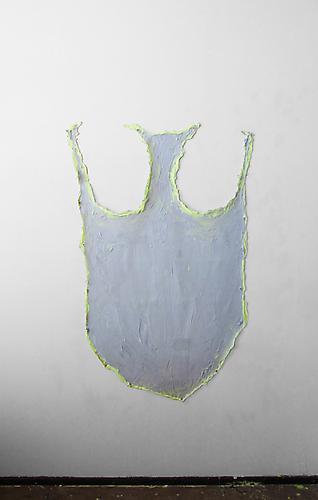
(Hallowed Be Thy Name)
Bret Slater has a small show of small works in the small project space, THE STUDY, in Morgan Lehman. They are seemingly clumsy but coherent and surprising. Fun paintings with clever titles, you can imagine that Slater took "You can't shine shit," as a personal challenge, and the result was better than he imagined. I particularly liked an oddly shaped painting which resembled both a patched one-piece bathing suit and the silhouette of a demonic bat titled "Hallowed Be Thy Name."
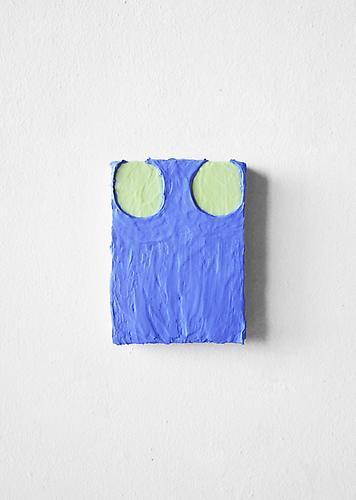
(Grandma Take Me Home)
Definitely check this one out. It runs until April 27th. For more information you can visit Morgan Lehman's website or that of the artist's.
#Bret Slater#Morgan Lehman#The Study#Project Space#Painting#Sculpture#Art#Show#New York#Before it's too late
3 notes
·
View notes
Text
"RAZZMATAZZ" - JACKIE MEIER at Nancy Margolis

(Synthetic Charm)
Meier's work is that of a colorist, and less of a theorist. It relies on an emotional and gravitating reaction to color. She asserts in her artist statement that "...the color dictates, and the shapes must obey." Color is her strongest and most honed weapon- yet, in this exhibition it felt as though perhaps the armory door has creaked open and the salty air has created some rust.
Many of the paintings rely on heavily geometric strips and repeating 45 and 90 degree angles within square supports - these are argued to be emulating the magic shifting and radiating energy of a kaleidoscope as it begins to turn. However, the most potent energy of the kaleidoscope - the surprise - has become subservient to the format. Meier has allowed the shapes, and the repeating woven format of these hard geometric strips, overtake the inventive use of color.
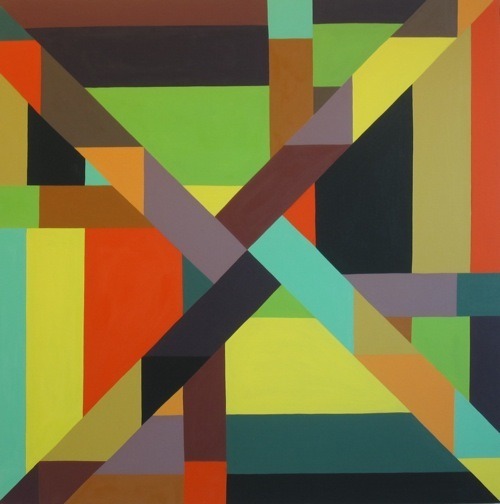
(Boogie)
However, when she hits the mark her command of color can be impeccable. Paintings such as "Boogie," which follow the same standard compositional techniques as many of the other works in the exhibition, seem fresher, as the slightly-darker and desaturated colors convey more of a deep-steeped cool. This is more potent; thick and swampy jazz. The colors slip and blue the notes - their visual rhythms swing. Many of the others are stilted and mechanical - closer to neo-rave. They are saturated, but un-pungent: they lack funk.
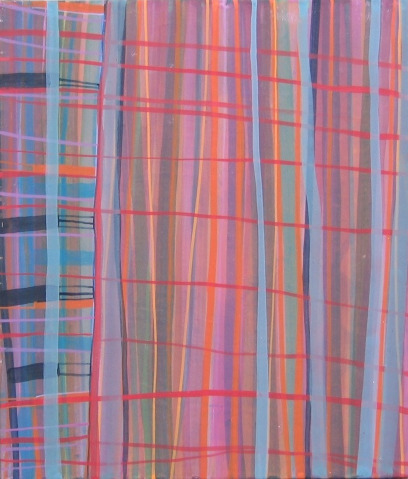
(Duped)
Looking at past works, such as "Duped (2007)," which seems heavily influenced by tapestry, the viewer can begin to see the formation of these newer works. In one of her small gouache drawings, where there is more translucency, the strips seem less mechanical, more engaging.

The overlapping portions are not tightly bound and rigid, rather they are intentional obfuscations - hiding pathways through the painting like a spy evading a tail. Naturally, we are caught up in the game.

(Midnight Moon) 2010

(Untitled) 2010
While some of Meier's older paintings seem more explorative in their compositional make-up, or at least more inventive - such as "Midnight Moon" and "Untitled" from 2010, which both have fauvist moments that remind me of Dove's "Dancing WIllows," we can see that there are newer influences to this work. They are visually becoming less like Hans Hofman and more like Frank Stella, but without the sense of object or heavy focus on theory. The regular intervals and subtlety in the colors can bring to mind Josef Albers, but again they are less reliant on theory. And so we are left, like I have mention before, on color.
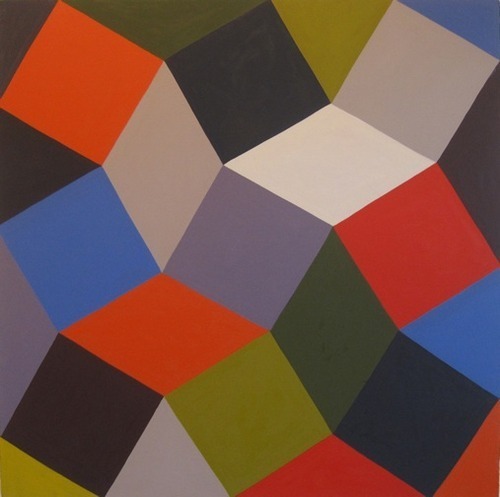
(Tumble)
I believe Meier is expanding her palette, and that the rigid structures in composition she set up for herself in these new pictures serve as a net into which to place these new finds. "Tumble," which is not as centrally oriented and seems to cascade, slips this rigid agreement. The color and shapes compete for the prominence.
While I am not overly taken with the majority of the works in "Razzmatazz," especially the multi-paneled pieces, I appreciate that there is a level of variation in her color that has up to this point been absent, and that once these new hues become increasingly comfortable - more understood and self-assured, they will once again forcibly command the shapes into new and exciting arrangements. For now this is a kaleidoscope – teetering on a precipice; potential energy waiting for a small bump.
I would recommend you visit "Razzmatazz," which is open through May 4th. You can find more information at Nancy Margolis, and you can also check out the catalog essay, "Infinite Divisibility," by Mark Dagley (in which, you can imagine, we disagree on quite a few points but he is much more articulate than myself).
NOTE IN THE MARGINS: - I saw someone who I thought was my friend Will in the gallery. I went up to say hello, and realized I was mistaken as he turned, lost his footing, and backed into a painting. It was when I saw the look of horror on his face that I realized it was not Will.
- Nancy Margolis is one of the only remaining galleries that is not a brightly lit white cube. It had much moodier lighting. I wonder what these paintings would look like in the cube.
#nancy#margolis#gallery#jackie#meier#painting#hard#geometric#abstraction#fauvism#criticism#colorist#new york#contemporary art#review
0 notes
Text
SPHERES (1-20) - Sara Ludy at Klaus Von Nichtssagend

(Still from "SPHERES 1-20)
Sara Ludy had her first solo show, "SPHERES" at Klaus Von Nichtssagend on the Lower East Side last month, and it did not disappoint. The show consisted of a single looped video, projected in the small square space - which was the perfect viewing venue.
The video features 20 one-minute segments, each focused on a computer-generated 3-D environment, with a constantly shifting and rotating central form and a synth-pad tone accompanying each episode. At first the video seems all too common-place in today's world of new-media art, teetering on the edge of becoming a Windows 95 screensaver parody. However, as the hovering central "sphere" forms begins to shift and rotate this dismissal melts away - they are too surprising, too complex to be relegated to the genre of 90's-era imitation alone.

The world the "spheres" inhabit touch on many references, drawing connections ranging from both the menacing and humming obelisk and psychological wormhole of Kubrick's "2001- A Space Odyssey," to this scene from Aladdin, to various video-game levels (which becomes apparent as the videos abruptly shift from segment to segment), to architectural CAD models.
The most interesting components of the video are the various rotating spheres. It brings to mind the experience of walking around Serra's "Torqued Elipses" - the viewer creates a mental model of the object in front of them, but as the forms are unique this mental model is always trying to catch up, progressively updating, changing constantly. Ludy's spheres operate in the same way, revealing themselves slowly, unfolding and warping over the span of a minute. You can begin to feel as though you understand the form, gain familiarity with its structures and colors and then, before you can hold onto this revelation for long, an abrupt shift to a new environment occurs. The resolution perpetually remains seconds out of reach.

The work prompts contemplation, and is especially relevant for those who were reared on video-games, spending hours focusing on a character whose world unfolded around them. The spheres always occupy the center of the projected image - static, while their environment moves relative to them and around them, similar to characters in Mario or Duke Nukem. The language of these games is the point of departure, but not quite familiar. The viewer is confronted with an avatar that is ever-changing and amorphous. You can find yourself constantly shifting my perspective from external viewer to inhabitant, and back again.
There is one portion of the work which seemed superfluous, and was only hinted at in the press release, which is that the projections originate on the computer, are projected onto colored paper in the artist's studio and recaptured using a digital camera - the result of which is then projected onto the gallery wall. While this process undoubtedly changes the projected image there is nothing in the actual work that points to this redundant process. It does not seem to help or detract from the impact of the work, and seems like an unnecessary aside.

Overall I was very impressed with this show, especially since it had to win me over from a point of immediate dismissal. I applaud Ms. Ludy for a strong first solo show as well as Klaus Von Nichtssagend for their excellent presentation of the work and I enthusiastically look forward to future showings by the artist.
You can find more information on Sara Ludy here and on Klaus Von Nichtssagend here.
NOTES FROM THE MARGINS:
- Walking into this gallery already feels precarious as you move through a narrow hallway with bicycles and ladders, but feels especially ominous when you hear a deep continuous tone behind a dark black curtain. Very cinematic - reminded me of Club Silencio from David Lynch's "Mulholland Drive" (and I suppose now his real club of the same name in Paris).
- When I peered behind the second black curtain for more information I saw curator Adrianna Campbell sitting at a desk, making it about the 10th time I'd seen her around town in a month.
#Klaus#Von#Nichtssagend#Klaus Von Nichtssagend#Sara#Ludy#Sara Ludy#Spheres#Video#Art#Artist#Gallery#Show#New York#Lower East Side#Video Games#90's computer#Computer generated#3d
4 notes
·
View notes
Text
BEFORE IT'S TOO LATE: "CIUDAD SUADADE: Architectures of Memory" at Reverse Space
BEFORE IT'S TOO LATE will be a continuing feature of a show that is worth checking out and closing in the near future.

(Rubens Ghenov, "A Avara do Fogo" )
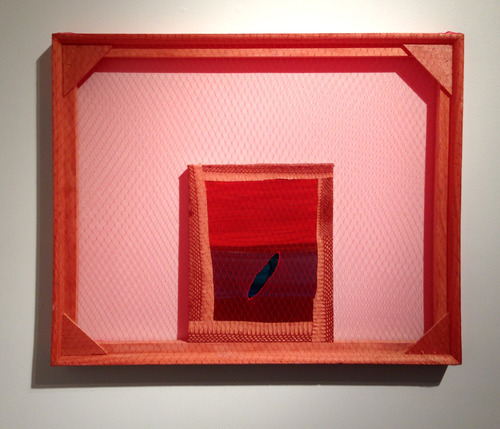
(Lumin Wakoa, "a tear in the fabric" )
In this first installment I highly recommend a vey strong and very full first curatorial effort by Christian Berman titled "Ciudad Suadade: Architectures of Memory." It features the works of Echo Eggebrecht, Ted Gahl, Rubens Ghenov, Laini Nemett, Kanishka Raja, Lumin Wakoa, Aaron Wexler and Christian himself. The paintings and sculptures center around the idea of reconstructing and re-imagining memories - presenting variations on the theme, distilled through eight different lenses.
I highly recommend you make it out to REVERSE, 28 Frost St., Brooklyn, New York 11211. Show will be closing March 31, 2013.
For more info, check out the REVERSE website.
#Reverse Space#Reverse#Art#Shows#Galleries#New York#Ciudade Suadade#Christian Berman#Echo Eggebrecht#Ted Gahl#Rubens Ghenov#Laini Nemett#Kanishka Raja#Lumin Wakoa#Aaron Wexler#Painting#Artists#Memory#Architectures#too late
0 notes
Text
"DECENTER" At the Abrons Art Center

(Doug Melini - "Favorable Transformations")


(Screenshots I took from my Vine because I forgot to talk pictures)
Because it was a month ago and I took no notes this will be very brief. The evening featured two separate discussions, each reflecting on the impact and legacy of the Armory show. The first panel focused primarily on the history of the Armory and the immediate impact it had on the American art world (introduction of Modernism, etc).
Professor Israel Rosenfield from CUNY introduced the second panel on "Perception and Art in the Digital Age." He touched on issues of perception and memory and why Duchamp's "Nude Descending a Staircase" might really be as radical and provocative to a viewing audience not yet familiar with Cubism and other forms of Modern art. He also showed a video of an experiment on color and its subjectivity and that what we perceive to be the outside world only exists once it has entered through the eyeballs into the brain. I cannot find the video online, despite trying for sometime. I failed at Youtube.
Finally there was the panel on art in the digital age by some heavy hitters in the new-media world such as Andrew Kuo and Travess Smalley. (CLICK HERE for a full list of speakers at the panel).
Because my notes were non-existant I will spare you my recollections and instead suggest you check out the digital-exhibition and go see the physical show in person.
NOTES IN THE MARGINS:
- I had heard Doug Melini give a lengthy talk on his work once and really appreciated his comments, but the digital flattening of his work really ruined it for me. His paintings are much much much better observed in person.
- The Abrons Art Center is wonderful but I accidentally got lost searching for the auditorium and ended up in a piano practice space. It is a bit of a maze if you make the first wrong turn.
#DECENTER#Adrianna Campbell#Daniel S. Palmer#Armory#Show#Panel#Discussion#Talk#Review#Art#Painting#New#Media#Abrons Art Center#Duchamp
1 note
·
View note
Text
SHANNON EBNER: "TYPE ON TYPE: On Bernd & Hilla Becher" - DIA Artist on Artist Lecture

(Hilla & Bernd Becher)

(Shannon Ebner's "RAW WAR")
It was great to see the contrasting styles between the lecture given by Ms. Ebner and the other I have already profiled by David Diao, and I am quite excited to see the terminus in this season's series in April, "Haim Steinbach on On Kawara."
While Mr. Diao's talk on Barnett Newman was sprawling and full of casual observations and anecdotes, both historical and personal, Ms. Ebner was fairly concise in comparison; she constructed her address in three short parts: A reading of her own writing, an excerpt from Gertrude Stein's "The Making of Americans," and lastly a song by rag-and-jazz-great, Fats Waller.

(Bernd & Hilla Becher, "Typologies")
Ms. Ebner's own writing, an essay produced in response to the re-exhibiting of William Jenkins "New Topographics," (in which the Bechers' work was included), focused on an idea of the "continuous-present," or as she re-named it: "IS-ivism." To always be in the present. She posited that in the Bechers' photographs, where they are consumed by the typologies of industrial architecture, they took very careful measures to isolate the structures from the surrounding background - to remove them from time and place. These photographs of the structures (or "anonymous sculptures," as they referred to them), would therefore "always be present, always be contemporary." They existed in an "anti-place" or "anti-landscape," in comparison with the other photographs shown in "New Topographics," such as work by Joe Deal or Lewis Baltz, whose works often had immediate signifiers for a static place in time- such as a car from a certain decade.
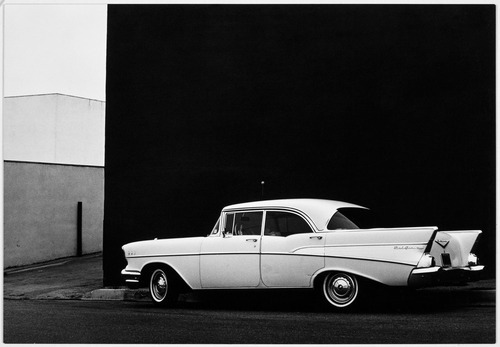
(Lewis Baltz, from "The Prototype Works")
As Ms. Ebner spoke she illustrated her point by projecting photographs by the Bechers. These photographs were all focused on similar subjects - forgotten and anonymous architectures. They all seemed to be of the same type, sorted into small grids for our ease of assignment. Even though as many as 30 years may have elapsed between one picture and the next they existed in the same theoretical space. Because of the care to capture each image of these structures, all on overcast days, with minimal shadows and isolated from their surroundings, the structures became removed; non-temporal.
Ms. Ebner read an illuminating quote, which I missed the attribution and therefore will paraphrase:
"The world is not black and white - It would be much easier to sort things into black or white, or a mixture of the two, which is gray. In color it is difficult to see exactly where something falls along this spectrum. Gray then is the color of theory. Therefore, black and white images are theoretical. They never existed - they are an idea." (Although we could may scientific and physiological arguments that colors as well do not exist but let us leave that for another post).
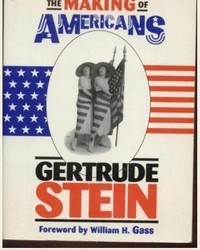
The next portion of the talk was a reading of an excerpt from Gertrude Stein's "The Making of Americans." Ms. Ebner drew a commonality between the "IS-ivism" of the Bechers' photographs, this insistent contemporaneity, and Stein's writing-style in "...Americans." Stein created a new form of writing in order to mimic her desire and urgency to be in the "now" - to address, at every moment in her text, the present. The passage Ms. Ebner read described types of men, and then onto types of people. It was Steins attempt to write, in rhythmic repetition, a description of every type of person that could live, and therefore does live.

(Excerpt from "The Making of Americans," by Gertrude Stein)
As Ms. Ebner read she continued to project images of the Bechers, this time only of one type - Water towers.
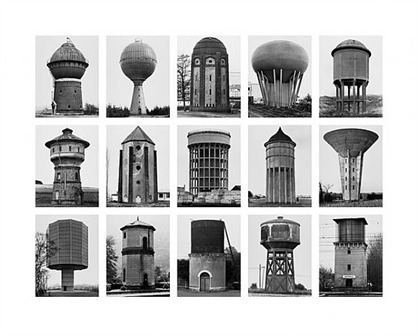
The repetition of Stein's words - the types of types, and the type of those types, then the types of those types became hypnotic, while the images appeared and evaporated into the next - a background of endless architectural "singular" types alongside the rhythm. Anonymous and synonymous.
And then the speech was over, and we were led out of our rhythmic lull by Fats Waller and his "Minor Drag," which Ms. Ebner received from Hilla Becher as a song that had meant much to her and her husband.
I was left with a few questions imparted, I'm sure, by my particular position in a large Chelsea building surrounded by Manhattan ringed by the Megalopolis (to borrow Gottman's term):
• Would the Buchers' photographs be possible now, in an increasingly industrial world, where isolating single instances of architecture becomes increasingly difficult, especially in an urban landscape like New York City? Does this mean that the non-temporal landscapes is soon to be extinct? (I think now of my first day of my first class in school, a seminar in the Metropolitan Studies department, and my professor's proclamation that TIME in fact was a construction arising out of industrialization. To engage Ms. Ebner and the Buchers, perhaps industrialization eventually squeezes out the non-temporal theoretical space, extinguishes the anti-place.
• As this extinguishing occurs it would appear that whatever locus the remaining "non-temporal" space could occupy would necessarily shift from what used to be developing-urban area to increasingly rural ones. This poses an interesting thought - that if the Bechers were to have continued their exploration of these "Anonymous Sculptures" into the present and beyond that their physical location, their actual and temporal place, would gradually shift away from the center, marked by their beginning photographs. I enjoy imagining that as these grids of anonymous water-towers filled with new arrivals, difficult to pictorially differentiate from the rest - the newer images would be receding further and further away from the original centers of production.
NOTES IN THE MARGINS:
-Shannon Ebner, while reading her own writing, stumbles over the word "oeuvre" because she begins laughing, and says "I can't ever say that word seriously."
- A quote from the introduction to Gertrude Stein's book: "You cannot tell what a picture really is until you dust it everyday, and you cannot tell what a reading is until you have to type it out or edit it."
#Shannon Ebner#Shannon#Ebner#DIA#DIA Beacon#Chelsea#New York CIty#Art#Lecture#Talks#Gertrude Stein#Gertrude#Stein#Bernd Becher#Hilla Becher#Bernd#Hilla#Becher#Bernd and Hilla#Photography#artists#review#criticism#talk#talks
0 notes
Text
MAX WARSH "BILDER" at Toomer Labzda
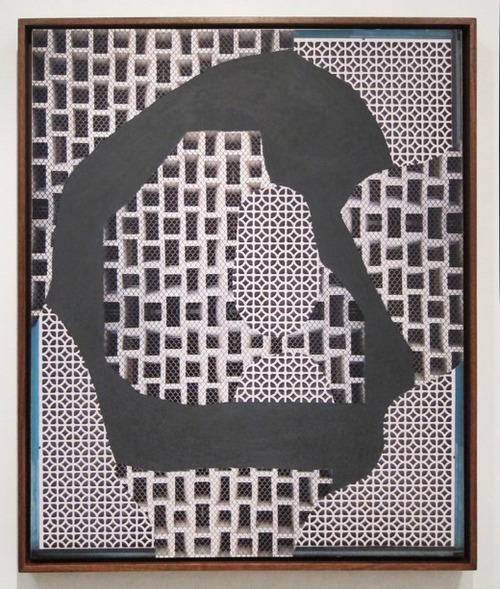
(Green Island)
The works are constructed with photo-collage and acrylic paint, extracting pattern and palette from the various building materials Warsh photographed. The show title, "BILDER" is German for "Picture," a clever play as Warsh constructs each picture from found structures, re-imagining their architectures into supports within the frame. They become abstracts on a firm foundation, switching readings from city plans to color-blocks, with certain patterns becoming akin to white noise.
The paintings success however hinges on the surprising facture- Although the painting and photography elements are themselves starkly flat, the layers and tangential relationships are unexpected. The elements bleed into one another, pause, exist on the same plane, or dissolve.
There are additionally some ready-made sculptures in the show - conveyor belts hung vertically along the walls, becoming tapestries rather than tools of capital. They are abstracted, like the bricks, fences and building blocks of the photographs, into decorative elements.
I am looking forward to seeing more work from Walsh in the future. You can read more information about the show at Toomer Labzda.

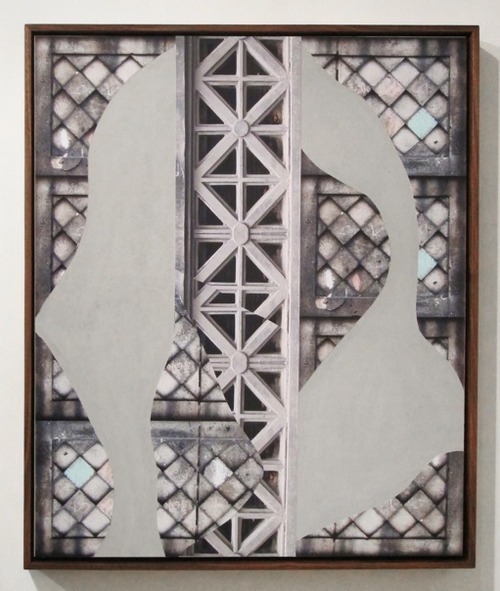

NOTES IN THE MARGINS:
- I have got to start desaturating my own paintings, these look awesome - I perhaps had one too many drinks and asked for the price list. I realized this makes you the gallerist's best friend.
0 notes
Text
MEGHAN BOODY at Aperture Foundation

The talk was a collaboration between the Aperture Foundation and the Parsons School of Photography I believe, and I had invited quite a few friends to come see it, only one of which made it. I almost immediately regretted this outreach because the talk began with an "avatar-visioning-meditation" where we were instructed to close our eyes and imagine a perfect version of ourselves rotating naked in the cosmos. The perfect version of ourselves "can have your real physical attributes...or the skin of a 12-year old." Upon hearing this I was almost sure my friend would not accept any more of my invitations.
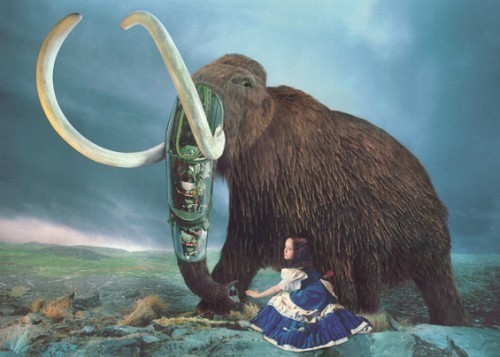
Ms. Boody's work did not particularly hold my interest- aesthetically they reminded me of fantasy novel illustrations, something you might run into trolling through the chasm of Deviant Art portfolios. They present young girls and women in various constructed stories. Some of girls trapped in a wasteland. Some of girls escaping boarding houses, or vampires and monsters. Some of twins in caverns. The works are digitally constructed in photoshop, although there didn't seem to be much of a conceptual reason given for the digital manipulation of the images. The few images which I found partially interesting or compelling were unfinished, and Ms. Boody would make a comment in a matter-of-fact way such as "Oh, well I obviously need to add wings to the horses."
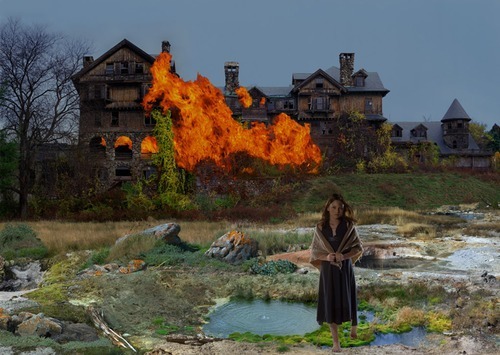
The frustrating part of the talk was that Ms. Boody seemed to be following some sort of internal logic of which she made no attempt to illuminate her audience. There were many instances where she made statements about the work such as a description of a character from one photograph who was merged with a frog saying "She has frog skin as a shield." This was not elaborated upon - whether the frog skin had some allegorical purpose or metaphor, etc. It felt more like, "She has frog skin as a shield because, duh, it is obvious." The work was all Victorian fantasy and fluff and her descriptions of the work used the language of melodrama. It was all cliche and self-indulgence - as I once heard in a critique of similar works "it deals in over-the-top terms with the minute problems of a very well adjusted person."
NOTES IN THE MARGINS:
-My avatar did not have the skin of a 12-year-old girl
- The talk seemed to have the same narrative string as watching a conspiracy theorist video on Youtube. A + B = X so that must mean Y. Russel Crowe in A Brilliant Mind.
-I never thought I would have to write down "Various fetuses that have gone astray..." in my notes.
6 notes
·
View notes
Text
DAVID DIAO at DIA on BARNETT NEWMAN

Mr. Diao spoke on the work of Barnett Newman at length - however, his talk was less academic and rather meandering and anecdotal, and served to show the connection between Newman's paintings and the influence they had on Mr. Diao's work. The audience was mostly rapt, with a few exceptions of die-hard Knicks fans who would attempt discreet glances at the scores every few minutes. The atmosphere was wonderful - it felt as though many members of the audience had direct ties to either Barnett Newman or Mr. Diao personally- and at the points where Mr. Diao would search for the name of such-and-such gallerist at this-or-that space, someone inevitably shouted out the answer as if it were a boisterous conversation about art at a dinner party.

(DAVID DIAO holds the paintbrush with which Barnett Newman painted Concord. Everyone was giddy)
Mr. Diao spoke about the crippling reception to Barnett Newman's early works - at the time he was thought of only as a critic and not an artist, known more for "intelligence in putting into words his thoughts, when he was unable to achieve the same in his paintings." Apparently Motherwell thought that Newman's first paintings were put-ons, a critic poking fun at the styles of the days. He described Newman's works as flat-footed and dry. However, the younger artists saw value in his works, such as Frank Stella and Jasper Johns, and it is through the appreciation of the up and comers that he first becomes accepted as an artist apart from critic.
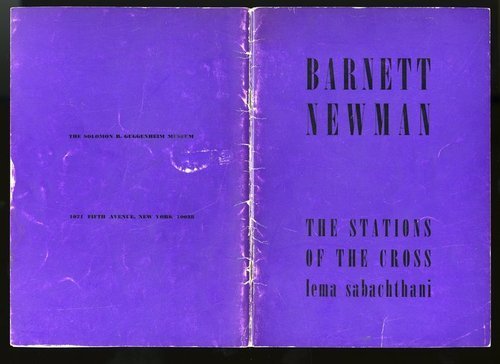
Diao then showed some of his own paintings: info-graphics inspired directly by Newman's catalog. There were pieces of mimesis, carrying the feelings of the sharp vertical zip - however these lines were created by text elaborating the sales of Newman's work in a certain time period, or the scale. Diao showed an obvious fascination with the master, recalling his experience of the Newman's "Stations of the Cross" when they hung in the Guggenheim, describing walking through as a pilgrimage, arriving at final transcendence at the coda, "Be Now."
It was heartening to see such adoration for Newman, a familiarity as well as reverence. He was the knowledgable grandfather - immortal in that room. the talk also helped me to become more familiar with Diao's work, which I would highly recommend.
The DIA holds an "Artist on Artist" lecture about once a month, and you may find the schedule HERE. I highly recommend that you reserve a ticket.
NOTES IN THE MARGINS:
-The first mistake I made was not reserving a ticket, and the second mistake I made was drinking a bottle of water before the lecture began. This second mistake caused me to miss about ten minutes of Mr. Diao's lecture, and the embarrassment of having to dislodge 25 people from their resting positions leaning against a wall in order to escape to the restroom.
-Seeing Jerry Saltz and Roberta Smith holding hands and together taking notes in the front row was heartwarming.
-Watching Phillipe Verne with a grin on his face, peeking in and out periodically from behind a curtain
-The biggest winner in the New York art world seems to be male-pattern baldness
#DIA#DIA BEACON#Chelsea#art#barnett newman#newman#david diao#diao#painting#lecture#reviews#criticism#review#talk#talks#lectures
0 notes